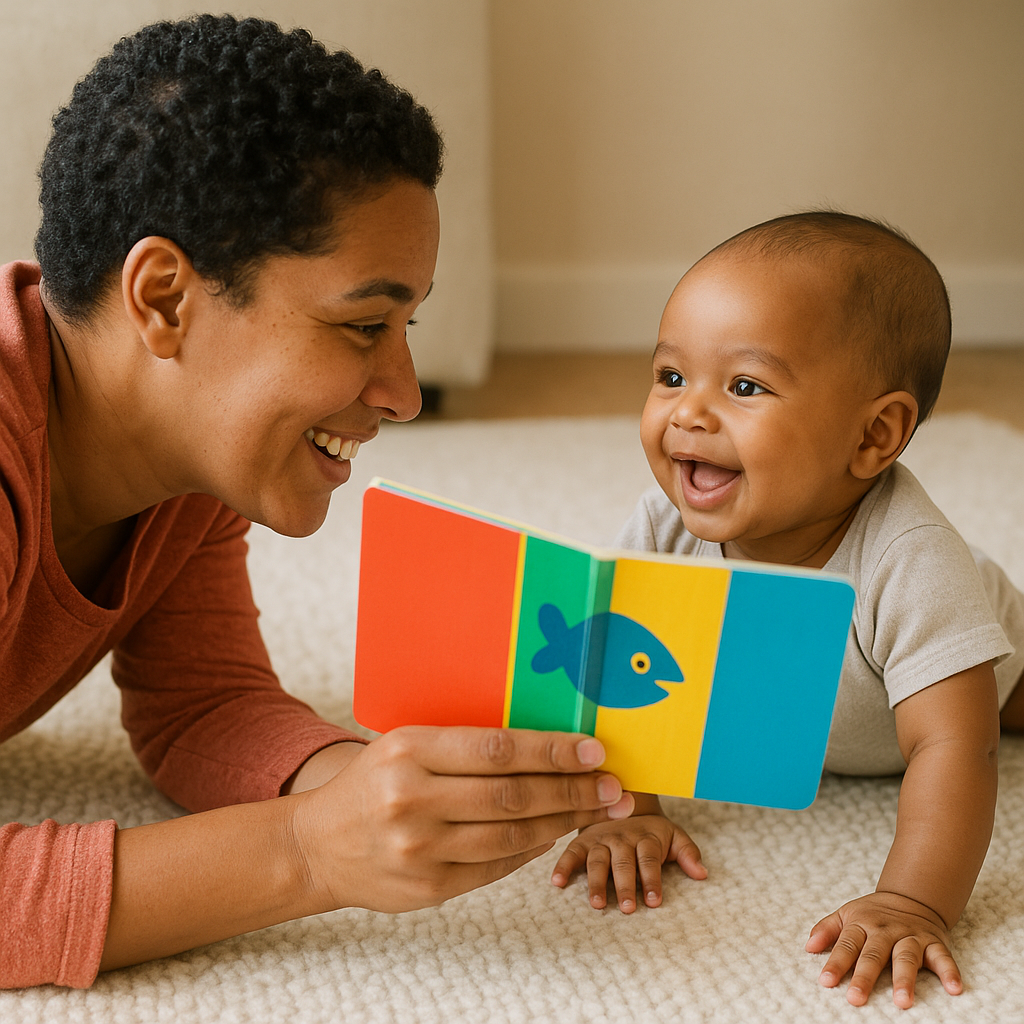Did you know most babies can recognize the sounds of their native language by just 6 months—even before they utter a single word? From that first coo to the triumphant “mama,” every week of the first year brings fresh communication skills. Understanding what’s typical—and how to nurture it—helps you celebrate progress, calm worries, and spot concerns early.
- What month-by-month language milestones can you expect in your baby’s first year?
- Birth – 3 months: How does communication begin?
- 4 – 6 months: When does babbling start?
- 7 – 9 months: What new skills appear?
- 10 – 12 months: When do first words pop out?
- How do receptive and expressive language skills work together?
- What common gaps can parents face, and how do you fill them?
- Which everyday activities reliably boost baby language development?
- Which red flags may signal a speech or hearing delay?
- When should you seek professional help for language concerns?
- How do limited screens and rich interaction shape vocabulary growth?
- How Does Nutrition Support Language Development?
- Your Top Questions, Answered
- Final Thoughts: Ready to track those milestones?
What month-by-month language milestones can you expect in your baby’s first year?
Birth – 3 months: How does communication begin?
Crying, cooing, and eye contact are the first tools. Newborns startle at loud sounds, quiet when you speak, and use different cries for hunger or fatigue. Around 6 weeks, soft coos emerge, and by 2 months, your baby makes “serve-and-return” eye contact, laying the groundwork for conversation. They also recognize your voice and may start or stop sucking in response to sound when feeding.
Tip: “Serve-and-return” is a back-and-forth interaction where you respond to your baby’s sounds or gestures, encouraging them to communicate more.
4 – 6 months: When does babbling start?
Most babies launch into canonical babble between 4 and 6 months. Expect strings like “ba-ba” or “ma-ma,” laughter, and squeals. They respond to their own name and notice tone—smiling at praise, pausing at “no.” They also follow sounds with their eyes and pay attention to music. For tone tips, dive into Parentese.
7 – 9 months: What new skills appear?
Joint attention and early gestures arrive now. Your baby follows your gaze, reaches for toys, waves, and understands “no.” Complex babble (“ba-da-ga”) shows growing mouth control.
Fascinating fact: Deaf infants babble with their hands at this same age, proving babble is universal.
10 – 12 months: When do first words pop out?
Anywhere between 10 and 12 months, a first true word usually surfaces. Intentional pointing, clapping, and following one-step commands (“Come here”) show receptive leaps. By their first birthday, most babies have 1-2 words like “Hi,” “dog,” “Dada,” or “Mama.” Get ready by reviewing Helping Your Baby Say First Words.

How do receptive and expressive language skills work together?
Babies understand far more than they can say. By 9 months, many grasp 50 words yet can’t speak them. Listening lights up the temporal lobes, while speaking lags a few months as muscles and motor planning catch up. “Serve-and-return” chats—where you pause for your baby’s babble—stimulate both pathways. For a deeper brain dive, see Talking to Your Baby.
Tip to spot comprehension: • Note head-turns toward sounds
• Watch eye-tracking when you label objects
• Test simple requests like “Wave bye-bye”
What common gaps can parents face, and how do you fill them?
Bilingual homes, preemies, screens, and frustration gaps are normal challenges.
• Bilingual babies split vocabulary across languages; total count still matches peers. Find tactics in Raising a Bilingual Baby.
• Preemies reach milestones by corrected age; neonatology follow-up clinics can guide you.
• More than 1 hour of passive video doubles speech-delay risk—see Screen Time and Speech Delay.
• Teaching simple signs eases frustration and speeds speech; explore Baby Sign Language.
For more information, you can as well check on: PMC Bilingual Infant Study
Which everyday activities reliably boost baby language development?
Tiny tweaks in daily routines spark big gains.
- Talk through tasks: “I’m zipping your PJs—zip, zip!”
- Read five minutes nightly; high-contrast board books work wonders. Check Reading to Your Baby.
- Label objects in real time—Labeling Objects boosts vocabulary.
- Sing and clap to nursery rhymes; rhythm primes syllable awareness.
- Use parentese: real words in an animated tone. A Seattle study found a 25 % vocabulary bump at 18 months.

Which red flags may signal a speech or hearing delay?
Missing multiple milestones can indicate a problem.
• No social smile or cooing by 3 months
• No babble by 9 months
• No gestures or first word by 15 months
• Any loss of words or skills at any age
Print the NIH checklist and keep it on the fridge for quick reference.
When should you seek professional help for language concerns?
Act early—evaluation never hurts and often helps. Start with your pediatrician, who may order a hearing test and refer you to a speech-language pathologist (SLP). In the U.S., Early Intervention services are free or low-cost before age 3. A simple script: “I’m concerned my 10-month-old isn’t babbling. Can we talk about a referral?”
How do limited screens and rich interaction shape vocabulary growth?
Live conversation delivers over 90% of a baby’s vocabulary. The AAP advises less than 30 minutes of co-viewed screen time daily under age 2 as per PMC Screen Time Impact. Face-to-face chatter fires mirror neurons; passive video does not. Swap cartoons for an Interactive Storytime session and watch word counts climb.
How Does Nutrition Support Language Development?
Proper nutrition is essential for brain development, which supports language skills. Malnutrition can lead to delayed language development and other cognitive deficits. During pregnancy, adequate maternal nutrition is crucial for fetal brain growth. After birth, breast milk provides optimal nutrition for brain development, and introducing iron-rich foods around six months helps prevent iron deficiency, which can impair cognitive function. Dietary fats are also important, as they support the myelination of neurons, necessary for efficient neural communication as in ZERO TO THREE Nutrition Impact.
Your Top Questions, Answered
-
How many words should my 12-month-old say?
0–5 meaningful words is typical. Comprehension and gestures matter more than word count at this age. -
Does bilingualism delay speech?
No. Total vocabulary across both languages keeps pace with monolingual peers. -
Is my quiet baby just shy?
Possibly. If your baby responds to sounds, uses gestures, and understands simple words, quiet temperament is not a red flag. -
Can baby sign slow down talking?
Research shows signing can actually speed speech onset by reducing frustration and encouraging word pairing.
For a word-rich future, explore our 30 Million Word Gap explainer.
Final Thoughts: Ready to track those milestones?
From the first coo to that thrilling first word, your baby’s language journey is a remarkable blend of brain growth and daily interaction. Keep chatting, reading, singing, and watching for those joyful breakthroughs—you’re giving your child a voice that will echo for a lifetime.